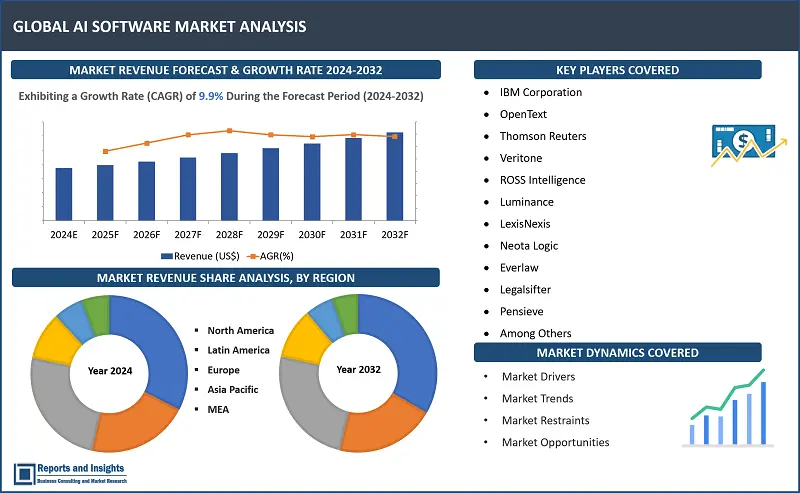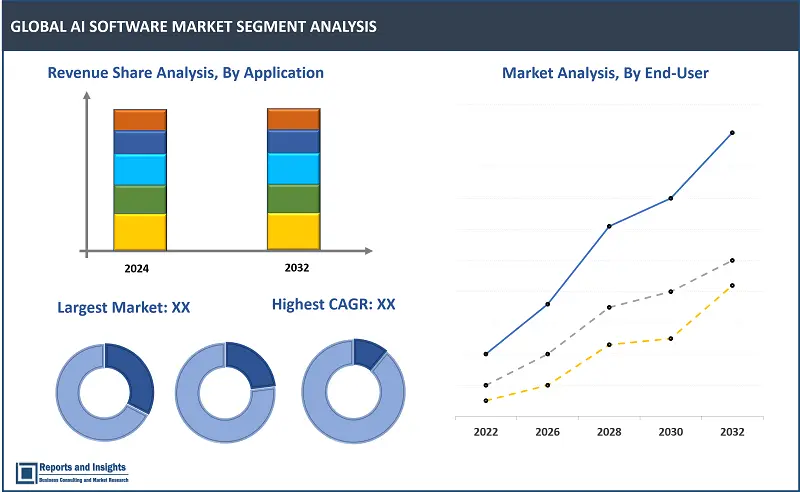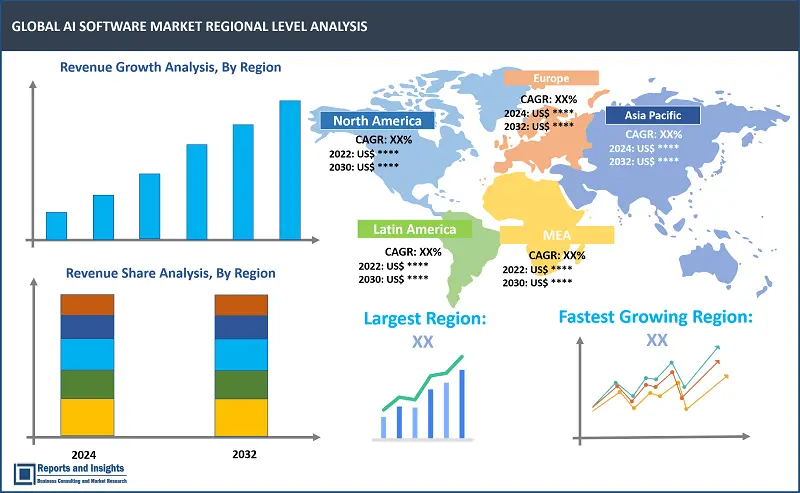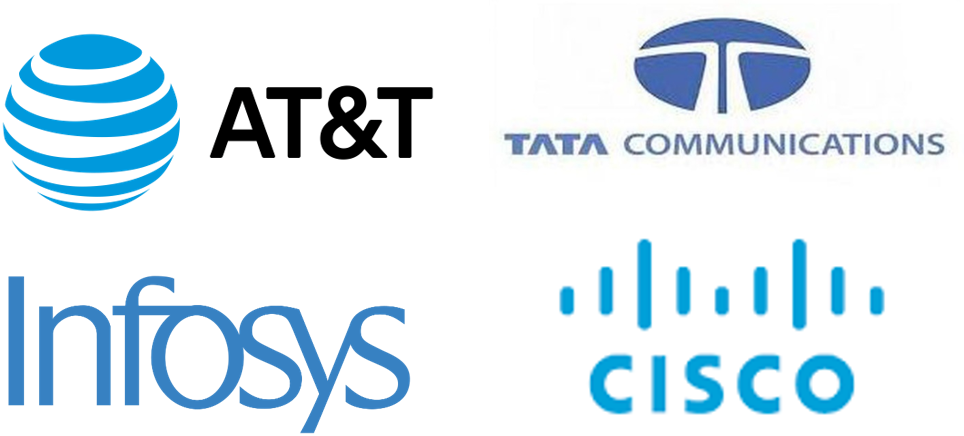Market Overview:
"The global legal AI software market size reached US$ 2.2 billion in 2023. Looking forward, Reports and Insights expects the market to reach US$ 5.2 billion in 2032, exhibiting a growth rate (CAGR) of 9.9% during 2024-2032."
|
Report Attributes |
Details |
|
Base Year |
2023 |
|
Forecast Years |
2024-2032 |
|
Historical Years |
2021-2023 |
|
Market Growth Rate (2024-2032) |
9.9% |
Legal AI software is software that uses artificial intelligence (AI) to aid legal professionals in tasks such as legal research, document analysis, contract review, and predictive analytics. This technology automates repetitive processes, improving efficiency, accuracy, and cost-effectiveness in legal operations. It also offers insights and supports decision-making, enhancing productivity in law firms and legal departments.
The legal AI software market encompasses a range of AI-powered tools and platforms designed to enhance legal operations. These solutions assist legal professionals in tasks such as legal research, contract review, and document analysis, leading to improved efficiency and accuracy. The market is driven by the growing demand for automation in the legal sector, the need to reduce costs, and the increasing complexity of legal work. Key players in the market offer innovative solutions that leverage machine learning and natural language processing to provide valuable insights and streamline legal work flows.

Legal AI Software Market Trends and Drivers:
The legal AI software market is primarily fueled by the increasing demand for automation and efficiency in legal operations, leading to cost reductions and improved accuracy. Another significant driver is the growing complexity of legal work, which requires advanced tools for tasks like research, document analysis, and contract review. Additionally, the rise of big data and the need for data-driven insights in legal decision-making are driving the adoption of AI technology in the legal sector. Key market trends include the development of AI solutions tailored to specific legal tasks, such as e-discovery and due diligence, as well as the integration of AI with other technologies like blockchain and cloud computing to enhance security and scalability.The legal AI software market growth is influenced by several factors which include the increasing demand for automation and efficiency in legal operations, which leads to cost reductions and improved accuracy. Another significant factor is the growing complexity of legal work, which requires advanced tools for tasks such as research, document analysis, and contract review. Additionally, the rise of big data and the need for data-driven insights in legal decision-making are driving the adoption of AI technology in the legal sector. Furthermore, the market is influenced by the development of AI solutions tailored to specific legal tasks, such as e-discovery and due diligence, as well as the integration of AI with other technologies like blockchain and cloud computing to enhance security and scalability.
Legal AI Software Market Restraining Factors:
Several factors act as restraints on the growth of the legal AI software market. These include concerns regarding data privacy and security, given that AI involves the processing and analysis of sensitive legal information. Additionally, there is a lack of awareness and understanding among legal professionals regarding the capabilities and benefits of AI technology, which hampers adoption. Moreover, the high initial investment needed for implementing AI solutions and the complexity of integrating AI with existing legal systems pose challenges to market growth. Furthermore, regulatory uncertainties and the potential for AI to replace certain legal jobs also contribute to restraining the market's growth.Legal AI Software Market Opportunities:
The legal AI software market offers numerous opportunities for expansion and advancement. One key area of opportunity is the rising demand for AI-driven solutions that enhance legal operations, boost efficiency, and lower costs. With legal work becoming increasingly complex, there is a growing need for advanced tools for tasks like legal research, document analysis, and contract review, creating a significant market opening. Additionally, integrating AI with other technologies such as blockchain and cloud computing presents further opportunities to enhance security, scalability, and functionality. Moreover, developing AI solutions tailored to specific legal tasks, along with expanding AI into new areas like regulatory compliance and risk management, provides avenues for market growth and innovation.
Legal AI Software Market Segmentation:

By Application
- eDiscovery
- Legal Research
- Contract Management
- Compliance
- Case Prediction
- Others
By Services
- Professional Services
- Managed Services
In the legal AI software market, professional services are currently the dominant service offering. These services encompass consulting, implementation, training, and support for legal AI software, assisting law firms and legal departments in effectively integrating and optimizing AI technologies. Professional services providers offer expertise in selecting the appropriate AI solutions, tailoring them to specific requirements, and ensuring seamless implementation and adoption. Managed services, which involve outsourcing the management of AI software and related infrastructure, are also gaining traction as organizations aim to streamline operations and focus on core legal activities, relying on external experts to manage their AI systems.
By Deployment
- Cloud
- On-Premises
Cloud deployment is the prevailing choice in the legal AI software market, surpassing on-premises deployment. This trend is fueled by the scalability, accessibility, and cost-efficiency of cloud solutions, which align with the requirements of law firms and legal departments. Although on-premises deployment remains relevant in scenarios demanding stringent data control and compliance, cloud-based alternatives are preferred for their flexibility and ease of implementation, gaining momentum in the legal sector.
By Technology
- Machine Learning and Deep Learning
- Natural Language Processing
In the legal AI software market, Natural Language Processing (NLP) takes precedence over Machine Learning (ML) and Deep Learning (DL). NLP's proficiency in analyzing and comprehending human language is vital for applications like document summarization, contract analysis, and legal research, all crucial functions in the legal sector. Despite the importance of ML and DL in legal AI, NLP's unique ability to interpret text data and extract meaningful information positions it as the dominant technology in this market.
By End-Use
- Corporate Legal Departments
- Law Firms
- Others
Law firms have historically been the primary users of legal AI software, dominating the market. This is largely due to their extensive utilization of AI tools for tasks such as litigation support, e-discovery, and document analysis. These solutions enable law firms to efficiently process vast amounts of information, enhance legal research capabilities, and improve overall decision-making processes. Although corporate legal departments are also adopting AI solutions, especially for contract analysis, compliance management, and legal research, law firms remain the key drivers of demand in the legal AI software market.
By Region

North America
- United States
- Canada
Europe
- Germany
- United Kingdom
- France
- Italy
- Spain
- Russia
- Poland
- Benelux
- Nordic
- Rest of Europe
Asia Pacific
- China
- Japan
- India
- South Korea
- ASEAN
- Australia & New Zealand
- Rest of Asia Pacific
Latin America
- Brazil
- Mexico
- Argentina
Middle East & Africa
- Saudi Arabia
- South Africa
- United Arab Emirates
- Israel
- Rest of MEA
North America leads the global legal AI software market, driven by its robust technological infrastructure and widespread adoption of AI in the legal industry. The region shows a strong demand for AI solutions that streamline legal research, contract analysis, and litigation support. Following closely behind is Europe, where countries like the UK, Germany, and France are increasingly integrating AI into legal practices. In Asia Pacific, rapid digitalization and AI adoption in countries such as China, Japan, and India are fueling market growth. While Latin America, the Middle East, and Africa are also witnessing a gradual uptake of legal AI software, they are progressing at a slower pace due to regulatory complexities and the early stage of AI adoption in their legal sectors.
Leading Legal AI Software Manufacturers & Competitive Landscape:
The legal AI software market is highly competitive, with several key players vying for market share and actively engaging in strategic initiatives. These companies focus on product innovation, technological advancements, and expanding their product portfolios to gain a competitive edge. These companies are continuously investing in research and development activities to enhance their product offerings and cater to customers' evolving needs in terms of efficiency, performance, and sustainability.
These companies include:
- IBM Corporation
- OpenText
- Thomson Reuters
- Veritone
- ROSS Intelligence
- Luminance
- LexisNexis
- Neota Logic
- Everlaw
- Legalsifter
- Pensieve
- Cognitiv+
- Casetext
- Klarity
- Omni Software Systems
- Nalanda Technology
- LawGeex
- Kira
- CaseMine
Legal AI Software Market Research Scope:
|
Report Metric |
Report Details |
|
Market size available for the years |
2021-2023 |
|
Base Year |
2023 |
|
Forecast Period |
2024-2032 |
|
Compound Annual Growth Rate (CAGR) |
9.9% |
|
Segment covered |
Application, services, deployment, technology, end-use and regions. |
|
Regions Covered |
North America: The U.S. & Canada Latin America: Brazil, Mexico, Argentina, & Rest of Latin America Asia Pacific: China, India, Japan, Australia & New Zealand, ASEAN, & Rest of Asia Pacific Europe: Germany, The U.K., France, Spain, Italy, Russia, Poland, BENELUX, NORDIC, & Rest of Europe The Middle East & Africa: Saudi Arabia, United Arab Emirates, South Africa, Egypt, Israel, and Rest of MEA |
|
Fastest Growing Country in Europe |
Germany |
|
Largest Market |
North America |
|
Key Players |
IBM Corporation, OpenText, Thomson Reuters, Veritone, ROSS Intelligence, Luminance, LexisNexis, Neota Logic, Everlaw, Legalsifter, Pensieve, Cognitiv+, Casetext, Klarity, Omni Software Systems, Nalanda Technology, LawGeex, Kira and CaseMine. |
1. Global Legal AI Software Market Report Overview
1.1. Introduction
1.2. Report Description
1.3. Methodology
2. Global Legal AI Software Market Overview
2.1. Introduction
2.1.1. Introduction
2.1.2. Market Taxonomy
2.2. Executive Summary
2.3. Global Legal AI Software Market Snapshot
2.4. Global Legal AI Software Market Size and Forecast, 2019–2027
2.4.1. Introduction
2.4.2. Market Value Forecast and Annual Growth Rate (AGR) Comparison (2019–2027)
2.5. Global Legal AI Software Market Dynamics
2.5.1. Drivers
2.5.2. Restraints
2.5.3. Opportunity
2.5.4. Trends
2.6. Key Regulations
2.7. Porter’s Five Forces Model
3. Global Legal AI Software Market, By Application
3.1. Introduction
3.1.1. Annual Growth Rate Comparison, By Application
3.1.2. BPS Analysis, By Application
3.2. Market Revenue (US$Mn) Forecast, By Application
3.2.1. eDiscovery
3.2.2. Legal Research
3.2.3. Contract Management
3.2.4. Compliance
3.2.5. Case Prediction
3.2.6. Others
3.3. Global Legal AI Software Market Attractiveness Index, By Application
4. Global Legal AI Software Market, By Component
4.1. Introduction
4.1.1. Annual Growth Rate Comparison, By Component
4.1.2. BPS Analysis, By Component
4.2. Market Revenue (US$Mn) Forecast, By Component
4.2.1. Solutions
4.2.2. Services
4.3. Global Legal AI Software Market Attractiveness Index, By Component
5. Global Legal AI Software Market, By Solutions
5.1. Introduction
5.1.1. Annual Growth Rate Comparison, By Solutions
5.1.2. BPS Analysis, By Solutions
5.2. Market Revenue (US$Mn) Forecast, By Solutions
5.2.1. Software solutions
5.2.2. Platform
5.3. Global Legal AI Software Market Attractiveness Index, By Solutions
6. Global Legal AI Software Market, By Services
6.1. Introduction
6.1.1. Annual Growth Rate Comparison, By Services
6.1.2. BPS Analysis, By Services
6.2. Market Revenue (US$Mn) Forecast, By Services
6.2.1. Professional Services
6.2.2. Managed Services
6.3. Global Legal AI Software Market Attractiveness Index, By Services
7. Global Legal AI Software Market, By Deployment
7.1. Introduction
7.1.1. Annual Growth Rate Comparison, By Deployment
7.1.2. BPS Analysis, By Deployment
7.2. Market Revenue (US$Mn) Forecast, By Deployment
7.2.1. Cloud
7.2.2. On premises
7.3. Global Legal AI Software Market Attractiveness Index, By Deployment
8. Global Legal AI Software Market, By Technology
8.1. Introduction
8.1.1. Annual Growth Rate Comparison, By Technology
8.1.2. BPS Analysis, By Technology
8.2. Market Revenue (US$Mn) Forecast, By Technology
8.2.1. Machine Learning and Deep Learning
8.2.2. Natural Language Processing
8.3. Global Legal AI Software Market Attractiveness Index, By Technology
9. Global Legal AI Software Market, By End Userr
9.1. Introduction
9.1.1. Annual Growth Rate Comparison, By End Userr
9.1.2. BPS Analysis, By End Userr
9.2. Market Revenue (US$Mn) Forecast, By End Userr
9.2.1. Corporate Legal Departments
9.2.2. Law Firms
9.2.3. Others
9.3. Global Legal AI Software Market Attractiveness Index, By End Userr
10. Global Legal AI Software Market, By Region
10.1. Introduction
10.1.1. Annual Growth Rate Comparison, By Region
10.1.2. BPS Analysis, By Region
10.2. Market Revenue (US$Mn) Forecast, By Region
10.2.1. North America
10.2.2. Latin America
10.2.3. Europe
10.2.4. Asia Pacific
10.2.5. Middle East
10.2.6. Africa
10.3. Global Legal AI Software Market Attractiveness Index, By Region
11. North America Legal AI Software Market Analysis and Forecast, 2019–2027
11.1. Introduction
11.1.1. Annual Growth Rate Comparison, By Country
11.1.2. BPS Analysis, By Country
11.2. Market Revenue (US$Mn) Forecast, By Country
11.2.1. U.S. Legal AI Software Market
11.2.2. Canada Legal AI Software Market
11.3. North America Legal AI Software Market, By Application
11.3.1. eDiscovery
11.3.2. Legal Research
11.3.3. Contract Management
11.3.4. Compliance
11.3.5. Case Prediction
11.3.6. Others
11.4. North America Legal AI Software Market, By Component
11.4.1. Solutions
11.4.2. Services
11.5. North America Legal AI Software Market, By Solutions
11.5.1. Software Solutions
11.5.2. Platforms
11.6. North America Legal AI Software Market, By Services
11.6.1. Professional Services
11.6.2. Managed Services
11.7. North America Legal AI Software Market, By Deployment
11.7.1. Cloud
11.7.2. On premises
11.8. North America Legal AI Software Market, By Technology
11.8.1. Machine Learning and Deep Learning
11.8.2. Natural Language Processing
11.9. North America Legal AI Software Market, By End User
11.9.1. Corporate Legal Departments
11.9.2. Law Firms
11.9.3. Others
11.10. North America Legal AI Software Market Attractiveness Index
11.10.1. By Country
11.10.2. By Application
11.10.3. By Component
11.10.4. By Solutions
11.10.5. By Services
11.10.6. By Deployment
11.10.7. By Technology
11.10.8. By End User
12. Latin America Legal AI Software Market Analysis and Forecast, 2019–2027
12.1. Introduction
12.1.1. Annual Growth Rate Comparison, By Country
12.1.2. BPS Analysis, By Country
12.2. Market (US$Mn) Forecast, By Country
12.2.1. Brazil Legal AI Software Market
12.2.2. Mexico Legal AI Software Market
12.2.3. Argentina Legal AI Software Market
12.2.4. Rest of Latin America Legal AI Software Market
12.3. Latin America Legal AI Software Market, By Application
12.3.1. eDiscovery
12.3.2. Legal Research
12.3.3. Contract Management
12.3.4. Compliance
12.3.5. Case Prediction
12.3.6. Others
12.4. Latin America Legal AI Software Market, By Component
12.4.1. Solutions
12.4.2. Services
12.5. Latin America Legal AI Software Market, By Solutions
12.5.1. Software Solutions
12.5.2. Platforms
12.6. Latin America Legal AI Software Market, By Services
12.6.1. Professional Services
12.6.2. Managed Services
12.7. Latin America Legal AI Software Market, By Deployment
12.7.1. Cloud
12.7.2. On premises
12.8. Latin America Legal AI Software Market, By Technology
12.8.1. Machine Learning and Deep Learning
12.8.2. Natural Language Processing
12.9. Latin America Legal AI Software Market, By End User
12.9.1. Corporate Legal Departments
12.9.2. Law Firms
12.9.3. Others
12.10. Latin America Legal AI Software Market Attractiveness Index
12.10.1. By Country
12.10.2. By Application
12.10.3. By Component
12.10.4. By Solutions
12.10.5. By Services
12.10.6. By Deployment
12.10.7. By Technology
12.10.8. By End User
13. Europe Legal AI Software Market Analysis and Forecast, 2019–2027
13.1. Introduction
13.1.1. Annual Growth Rate Comparison, By Country
13.1.2. BPS Analysis, By Country
13.2. Market (US$Mn) Forecast, By Country
13.2.1. U.K. Legal AI Software Market
13.2.2. Germany Legal AI Software Market
13.2.3. Italy Legal AI Software Market
13.2.4. France Legal AI Software Market
13.2.5. Spain Legal AI Software Market
13.2.6. Russia Legal AI Software Market
13.2.7. Poland Legal AI Software Market
13.2.8. BENELUX Legal AI Software Market
13.2.9. NORDIC Legal AI Software Market
13.2.10. Rest of Europe Legal AI Software Market
13.3. Europe Legal AI Software Market, By Application
13.3.1. eDiscovery
13.3.2. Legal Research
13.3.3. Contract Management
13.3.4. Compliance
13.3.5. Case Prediction
13.3.6. Others
13.4. Europe Legal AI Software Market, By Component
13.4.1. Solutions
13.4.2. Services
13.5. Europe Legal AI Software Market, By Solutions
13.5.1. Software Solutions
13.5.2. Platforms
13.6. Europe Legal AI Software Market, By Services
13.6.1. Professional Services
13.6.2. Managed Services
13.7. Europe Legal AI Software Market, By Deployment
13.7.1. Cloud
13.7.2. On premises
13.8. Europe Legal AI Software Market, By Technology
13.8.1. Machine Learning and Deep Learning
13.8.2. Natural Language Processing
13.9. Europe Legal AI Software Market, By End User
13.9.1. Corporate Legal Departments
13.9.2. Law Firms
13.9.3. Others
13.10. Europe Legal AI Software Market Attractiveness Index
13.10.1. By Country
13.10.2. By Application
13.10.3. By Component
13.10.4. By Solutions
13.10.5. By Services
13.10.6. By Deployment
13.10.7. By Technology
13.10.8. By End User
14. Asia Pacific Legal AI Software Market Analysis and Forecast, 2019–2027
14.1. Introduction
14.1.1. Annual Growth Rate Comparison, By Country
14.1.2. BPS Analysis, By Country
14.2. Market (US$Mn) Forecast, By Country
14.2.1. China Legal AI Software Market
14.2.2. India Legal AI Software Market
14.2.3. Japan Legal AI Software Market
14.2.4. Australia and New Zealand Legal AI Software Market
14.2.5. South Korea Legal AI Software Market
14.2.6. ASEAN Legal AI Software Market
14.2.7. Rest of Asia Pacific Legal AI Software Market
14.3. Asia Pacific Legal AI Software Market, By Application
14.3.1. eDiscovery
14.3.2. Legal Research
14.3.3. Contract Management
14.3.4. Compliance
14.3.5. Case Prediction
14.3.6. Others
14.4. Asia Pacific Legal AI Software Market, By Component
14.4.1. Solutions
14.4.2. Services
14.5. Asia Pacific Legal AI Software Market, By Solutions
14.5.1. Software Solutions
14.5.2. Platforms
14.6. Asia Pacific Legal AI Software Market, By Services
14.6.1. Professional Services
14.6.2. Managed Services
14.7. Asia Pacific Legal AI Software Market, By Deployment
14.7.1. Cloud
14.7.2. On premises
14.8. Asia Pacific Legal AI Software Market, By Technology
14.8.1. Machine Learning and Deep Learning
14.8.2. Natural Language Processing
14.9. Asia Pacific Legal AI Software Market, By End User
14.9.1. Corporate Legal Departments
14.9.2. Law Firms
14.9.3. Others
14.10. Asia Pacific Legal AI Software Market Attractiveness Index
14.10.1. By Country
14.10.2. By Application
14.10.3. By Component
14.10.4. By Solutions
14.10.5. By Services
14.10.6. By Deployment
14.10.7. By Technology
14.10.8. By End User
15. Middle East Legal AI Software Market Analysis and Forecast, 2019–2027
15.1. Introduction
15.1.1. Annual Growth Rate Comparison, By Country
15.1.2. BPS Analysis, By Country
15.2. Market (US$Mn) Forecast, By Country
15.2.1. GCC Countries Legal AI Software Market
15.2.2. Israel Legal AI Software Market
15.2.3. Oman Legal AI Software Market
15.2.4. Rest of Middle East Legal AI Software Market
15.3. Middle East Legal AI Software Market, By Application
15.3.1. eDiscovery
15.3.2. Legal Research
15.3.3. Contract Management
15.3.4. Compliance
15.3.5. Case Prediction
15.3.6. Others
15.4. Middle East Legal AI Software Market, By Component
15.4.1. Solutions
15.4.2. Services
15.5. Middle East Legal AI Software Market, By Solutions
15.5.1. Software Solutions
15.5.2. Platforms
15.6. Middle East Legal AI Software Market, By Services
15.6.1. Professional Services
15.6.2. Managed Services
15.7. Middle East Legal AI Software Market, By Deployment
15.7.1. Cloud
15.7.2. On premises
15.8. Middle East Legal AI Software Market, By Technology
15.8.1. Machine Learning and Deep Learning
15.8.2. Natural Language Processing
15.9. Middle East Legal AI Software Market, By End User
15.9.1. Corporate Legal Departments
15.9.2. Law Firms
15.9.3. Others
15.10. Middle East Legal AI Software Market Attractiveness Index
15.10.1. By Country
15.10.2. By Application
15.10.3. By Component
15.10.4. By Solutions
15.10.5. By Services
15.10.6. By Deployment
15.10.7. By Technology
15.10.8. By End User
16. Africa Legal AI Software Market Analysis and Forecast, 2019–2027
16.1. Introduction
16.1.1. Annual Growth Rate Comparison, By Country
16.1.2. BPS Analysis, By Country
16.2. Market (US$Mn) Forecast, By Country
16.2.1. South Africa Legal AI Software Market
16.2.2. Egypt Legal AI Software Market
16.2.3. North Africa Legal AI Software Market
16.2.4. Rest of Africa Legal AI Software Market
16.3. Africa Legal AI Software Market, By Application
16.3.1. eDiscovery
16.3.2. Legal Research
16.3.3. Contract Management
16.3.4. Compliance
16.3.5. Case Prediction
16.3.6. Others
16.4. Africa Legal AI Software Market, By Component
16.4.1. Solutions
16.4.2. Services
16.5. Africa Legal AI Software Market, By Solutions
16.5.1. Software Solutions
16.5.2. Platforms
16.6. Africa Legal AI Software Market, By Services
16.6.1. Professional Services
16.6.2. Managed Services
16.7. Africa Legal AI Software Market, By Deployment
16.7.1. Cloud
16.7.2. On premises
16.8. Africa Legal AI Software Market, By Technology
16.8.1. Machine Learning and Deep Learning
16.8.2. Natural Language Processing
16.9. Africa Legal AI Software Market, By End User
16.9.1. Corporate Legal Departments
16.9.2. Law Firms
16.9.3. Others
16.10. Africa Legal AI Software Market Attractiveness Index
16.10.1. By Country
16.10.2. By Application
16.10.3. By Component
16.10.4. By Solutions
16.10.5. By Services
16.10.6. By Deployment
16.10.7. By Technology
16.10.8. By End User
17. Recommendation
17.1. Market Strategy
18. Competitive Landscape
18.1. Competition Dashboard
18.2. List and Company Overview of Global Key Players
18.3. Company Profiles
18.3.1. IBM Corp.
18.3.1.1. Company Overview
18.3.1.2. Financial Overview
18.3.1.3. Application Portfolio
18.3.1.4. Key Developments
18.3.1.5. Business Strategies
18.3.2. OpenText
18.3.3. Thomson Reuters
18.3.4. Veritone
18.3.5. ROSS Intelligence
18.3.6. Luminance
18.3.7. LexisNexis
18.3.8. Neota Logic
18.3.9. Everlaw
18.3.10. Legalsifter
18.3.11. Pensieve
18.3.12. Cognitiv+
18.3.13. Casetext
18.3.14. Klarity
18.3.15. Omni Software Systems
18.3.16. Nalanda Technology
18.3.17. LawGeex
18.3.18. Kira
19. Acronyms
Frequently Asked Question
At what CAGR will the legal AI software market expand?
The market is anticipated to rise at 9.9% through 2032
What are some key factors driving revenue growth of the legal AI software market?
Some key factors driving legal AI software market revenue growth includes efficiency and cost savings, increased accuracy and risk reduction, growing demand for data-driven insights, rising complexity of legal work, and digital transformation in the legal sector
What is legal AI software?
Legal AI software, also known as legal tech or law tech, refers to technology solutions that use artificial intelligence (AI) and machine learning (ML) to streamline legal processes, improve efficiency, and provide insights for legal professionals.
What are some major challenges faced by companies in the legal AI software market?
Companies face challenges such as data privacy and security, integration with existing systems, regulatory compliance, skills gap, and cost and ROI.
How is the competitive landscape in the legal AI software market?
The market is competitive, with key players focusing on technological advancements, product innovation, and strategic partnerships. Factors such as product quality, reliability, after-sales services, and customization capabilities play a significant role in determining competitiveness.
How is AI used in the legal industry?
AI is used in the legal industry in various ways, including contract analysis, legal research, e-discovery, case prediction, and document automation. These applications help lawyers and legal professionals save time, reduce costs, and make more informed decisions.
How much does legal AI software cost?
The cost of legal AI software varies depending on the provider, the features included, and the size of the firm or organization.
Who are the leading key players in legal AI software market?
The leading key players in the legal AI software market are IBM Corporation, OpenText, Thomson Reuters, Veritone, ROSS Intelligence, Luminance, LexisNexis, Neota Logic, Everlaw, Legalsifter, Pensieve, Cognitiv+, Casetext, Klarity, Omni Software Systems, Nalanda Technology, LawGeex, Kira and CaseMine.

